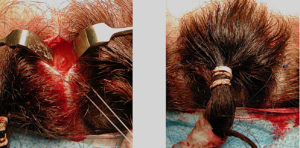The upper third of the face, which is composed of the skin bearing forehead and the hair bearing brows, is major aesthetic unit of the face. Like the rest of the face below it, it is equally exposed to changes caused by aging such as the development of horizontal wrinkles and a lowering of the brows. While the number one aesthetic treatment of the forehead are Botox injections, some patients will need actual forehead rejuvenative surgery for substantial improvement.
The main surgery for forehead rejuvenation is that of the browlift. While once a wide open procedure done using a long scalp scar, the trend over the past two decades has been to use a less invasive approach through endoscopic techniques. This fundamentally results in much less scalp scarring but what is done under the forehead flap is somewhat the same as in more open browlift procedures.
In the December 2014 issue of the journal Plastic and Reconstructive Surgery, an article on this topic appeared entitled ‘Finesse in Forehead and Brow Rejuvenation: Modern Concepts, Including Endoscopic Methods’. In this paper the author review their experience in 546 endoscopic browlift operations s a tailored approach to the endoscopic browlift using four small scalp incisions in normal length foreheads and permanent suture fixation through outer cortical bone tunnels. The endoscopic dissection is done in a more limited fashion at the medial brow level but mire extensive laterally to release the lateral brow retaining ligaments. In high or long foreheads a hairline incision is used and the frontal hairline is advanced and forehead skin removed to create a vertical forehead reduction at the same time as the browlift. No infections occurred in their series. They experienced no cases of permanent nerve injury of either the sensory or motor nerves. Only 2% of patients experienced any temporary hair loss issues. No case experienced any loss of brow fixation using suture fixation to cortical bone tunnels.
The endoscopic browlift is now the workhorse of surgical forehead rejuvenation. As this paper illustrates it can be used for a wide variety of brow sagging problems. Its limitation is that it will cause some increase in vertical forehead lengthening since it works through a generalized epicranial shift of tissues from the brows backward. In this cases a frontal hairline incision is needed to either keep the hairline at its existing location or to allow a simultaneous frontal hairline advancement with the browlift. The endoscope serves little use once a more open forehead technique is used.

Men remains a challenge for any type of browlifting due to the location and quality of their frontal hairline. (or often complete lack of it) This is why the transpalpebral browpexy technique, marginally effective as it is, is the browlift procedure of choice for many men. In men with reasonable fronta hairlines, however, I have been impressed with how well their scars can do as also evidenced in male frontal hairline advancements.
Dr. Barry Eppley
Indianapolis, Indiana


